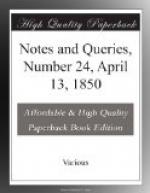As a first instalment of my promised notes on Milton’s Minor Poems, I have transcribed the following from my two copies, premising that “G.” stands for the name of Mr. Gilchrist, and “D.” for that of Mr. Dunster, whose name is misprinted in your 316th page, as “Duns_ton_.”
Notes on Lycidas.
On l. 2. (G.):—
“O’er head sat a raven, on a sere bough.”
Jonson’s Sad Shepherd, Act. I. Sc. 6.
On l. 26. (D.):—
“Whose
so early lay
Prevents the eyelids of the blushing
day.”
Crashaw’s Music’s Duel.
On l. 27. (D.):—
“Each sheapherd’s daughter,
with her cleanly peale,
was come afield to milke the morning’s
meale.”
Brown’s Britannia’s Pastorals, B. iv. Sc. 4. p. 75. ed. 1616.
On l. 29. (G.):—
“And in the deep fog batten all the day.”
Drayton, vol. ii. p. 512. ed. 1753.
On l. 40. (G.):—
“The gadding winde.”
Phineas Fletcher’s 1st Piscatorie Eclogue, st. 21.
On l. 40. (D.):—
“This black den, which rocks emboss,
Overgrown with eldest moss.”
Wither’s Shepherd’s Hunting, Eclogue 4.
On l. 68. (D.) the names of Amaryllis and Neaera are combined together with other classical names of beautiful nymphs by Ariosto (Orl. Fur. xi. st. 12.)
On l. 78. (D.) The reference intended by Warton is
to Pindar, Nem.
Ode vii. l. 46.
On l. 122. (G.):—
“Of night or loneliness it recks me not.”
Comus, l. 404.
On l. 142. (G.):—
“So rathe a song.”
Wither’s Shepherd’s Hunting, p. 430. ed. 1633.
On l. 165. (G.):—
“Sigh no more, ladies; ladies, sigh no more.”
Shakspeare’s Much Ado, ii. 3.
On l. 171. (G.):—
“Whatever makes Heaven’s forehead fine.”
Crashaw’s Weeper, st. 2.
J.F.M.
* * * * *
REPLIES TO MINOR QUERIES.
Depinges (No. 18. p. 277., and No. 20. p. 326.).—I have received the following information upon this subject from Yarmouth. Herring nets are usually made in four parts or widths,—one width, when they are in actual use, being fastened above another. The whole is shot overboard in very great lengths, and forms, as it were, a wall in the sea, by which the boat rides as by an anchor. These widths are technically called “lints” (Sax. lind?); the uppermost of them (connected by short ropes with a row of corks) being also called the “hoddy” (Sax. hod?), and the lowest, for an obvious reason, the “deepying” or “depynges,” and sometimes “angles.”
At other parts of the coast than Yarmouth, it seems that the uppermost width of net bears exclusively the name of hoddy, the second width being called the first lint, the third width the second lint, and the fourth the third lint, or, as before, “depynges.”




